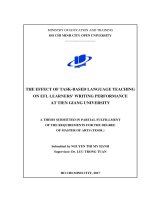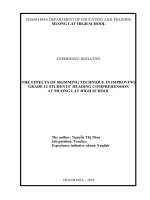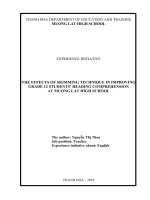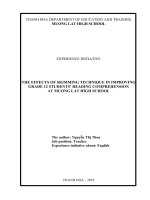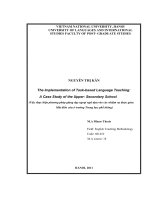The effects of task based language teaching on efl students’ reading comprehension at hoang dieu secondary school
Bạn đang xem bản rút gọn của tài liệu. Xem và tải ngay bản đầy đủ của tài liệu tại đây (6.63 MB, 106 trang )
MINISTRY OF EDUCATION AND TRAINING
HO CHI MINH CITY UNIVERSITY OF TECHNOLOGY
---------------------------
NGUYEN HA THAO MI
THE EFFECTS OF TASK-BASED LANGUAGE
TEACHING ON EFL STUDENTS’ READING
COMPREHENSION AT HOANG DIEU
SECONDARY SCHOOL
Major: English Language
Course code: 8220201
HO CHI MINH CITY, DECEMBER/ 2022
MINISTRY OF EDUCATION AND TRAINING
HO CHI MINH CITY UNIVERSITY OF TECHNOLOGY
---------------------------
Submitted to the
Faculty of English Language
in partial fulfillment of the Master’s degree in English Language
(18258 words)
Course code: 8220201
By
NGUYEN HA THAO MI
Supervised by
DUONG MY THAM, Ph.D.
HO CHI MINH CITY, DECEMBER/ 2022
The thesis entitled The effects of Task-Based Language Teaching on EFL students’
reading comprehension at Hoang Dieu secondary school was successfully defended
and approved on March 29, 2023 at Ho Chi Minh City University of Technology
(HUTECH).
Academic supervisor: Dr. Duong My Tham
Examination Committee
1. Nguyen Thi Kieu Thu, Ph.D.
Chair
2. Le Van Tuyen, Ph.D.
Reader 1
3. Nguyen Thi Thu, Ph.D.
Reader 2
4. Cao Thi Phuong Dung, Ph.D.
Member
5. Tran Quoc Thao, Ph.D.
Secretary Member
On behalf of the Examination Committee
Chair
i
HCMC UNIVERSITY OF TECHNOLOGY
POSTGRADUATE INSTITUTE
______________________
HCMC, ....................2022
MASTER’S THESIS REPORT
Student name: Nguyen Ha Thao Mi
Sex: Female
Date of birth: 15 June, 1997
Place of birth: Hanoi
Major: English Language
Student code: 2041900025
I- Thesis title:
The effects of Task-Based Language Teaching on EFL students’ reading
comprehension at Hoang Dieu secondary school
II- Objectives and contents:
This study is conducted to find out whether TBLT has impacts on students’ reading
comprehension at Hoang Dieu secondary school.
III- Starting date: 7 June, 2022
IV- Completing date: 23 December, 2022
V- Academic supervisor: Dr. Duong My Tham
ACADEMIC SUPERVISOR
FACULTY DEAN
(full name, signature)
(full name, signature)
ii
CERTIFICATE OF ORIGINALITY
I certify my authorship of the Master’s Thesis submitted today entitled:
THE EFFECTS OF TASK-BASED LANGUAGE TEACHING ON EFL
STUDENTS’ READING COMPREHENSION AT HOANG DIEU SECONDARY
SCHOOL
In terms of the statement of requirements for Theses in Master’s programs issued by
the Higher Degree Committee of Faculty of English Language, Ho Chi Minh City
University of Technology.
Ho Chi Minh City, December 2022
NGUYEN HA THAO MI
iii
RETENTION AND USE OF THE THESIS
I hereby state that I, NGUYEN HA THAO MI, being a candidate for the degree of
Master of Arts (English Language) accept the requirements of the University relating
to the retention and use of Master’s Theses deposited in the Library.
In terms of these conditions, I agree that the original of my Master’s Thesis deposited
in the Library should be accessible for purposes of study and research, in accordance
with the normal conditions established by the Librarian for the care, loan, and
reproduction for theses.
Ho Chi Minh City, December 2022
Signature ..................................
NGUYEN HA THAO MI
iv
ACKNOWLEDGEMENTS
I would first like to express my deepest gratitude to Dr. Duong My Tham, my
supervisor, for her patience, guidance, insightful advice, and constant encouragement
through the whole research process. Without her support and guidance, this thesis
would never have been completed.
I am grateful to Ms Nguyen Thi Kieu Thu and the teachers of English Falcuty of Ho
Chi Minh City University of Technology due to their guidance, thoughtful
suggestions, and continual encouragement during my entire study process.
I am also thankful for my students’ co-operation and contribution.
Lastly, I would like to convey my special appreciation to my family, friends and
colleagues who always give me support when I did the research.
v
ABSTRACT
Task-based language teaching has been considered one of the most effective
approaches that allow learners to produce as much English as possible through
meaningful tasks. Nevertheless, there have been very few studies conducted on the
implementation of TBLT in Vietnamese secondary education. This study aims to
investigate the impacts of Task-Based Language Teaching on EFL students’ reading
comprehension at Hoang Dieu secondary school. The participants included 73 eighthgraders at a Ho Chi Minh City-based secondary school. The students in experimental
groups experienced a 17-week experiment with the intervention of TBLT, while the
control group was taught traditionally. The tests and a closed-ended questionnaire
were employed to collect the quantitative data. The results revealed that the students
in the experimental group gave a better performance in reading comprehension than
those in the control group. Additionally, the majority of students in the experimental
group held positive attitudes toward TBLT in reading comprehension lessons. In
particular, the behavioral aspect obtained the highest agreement from the participants,
followed by the cognitive aspect and the affective aspect. It is therefore suggested
that EFL teachers should consider implementing TBLT to aid students in improving
their reading comprehension.
Keywords: Attitude, English as a foreign language, reading comprehension,
Secondary education, task-based language teaching
vi
TABLE OF CONTENTS
CHAPTER 1 .............................................................................................................. 1
1.1 Background of the study .................................................................................. 1
1.2 Statement of the problem ................................................................................. 3
1.3 Aims and objectives of the study ..................................................................... 5
1.4 Research questions ........................................................................................... 5
1.5 Scope of the study ............................................................................................ 6
1.6 Significance of the study .................................................................................. 6
1.7 Definition of the key terms ............................................................................... 7
1.8 Organization of the thesis ................................................................................. 7
CHAPTER 2 .............................................................................................................. 9
2.1 Introduction ...................................................................................................... 9
2.2 Reading comprehension ................................................................................... 9
2.2.1 Definition ................................................................................................... 9
2.2.2 Models of reading process ....................................................................... 11
2.2.3 Factors influencing reading comprehension ............................................ 13
2.2.4 Principles in teaching reading comprehension ........................................ 18
2.3 Task-based language teaching ........................................................................ 20
2.3.1 Definition ................................................................................................. 20
2.3.2 Procedures of task-based language teaching ........................................... 21
2.3.3 The implementation of task-based language teaching in language
classrooms ........................................................................................................ 25
2.4 Learning attitudes ........................................................................................... 26
2.4.1 Definition ................................................................................................. 26
2.4.2 Components of learning attitudes ............................................................ 27
2.4.3 Roles of learning attitudes in EFL learning ............................................. 28
2.5 Previous studies .............................................................................................. 30
2.5.1 The effects of TBLT on EFL students’ reading comprehension ............. 30
2.5.2 The effects of TBLT on EFL students’ vocabulary knowledge .............. 32
vii
2.5.3 The effects of TBLT on EFL students’ attitudes in reading
comprehension .................................................................................................. 33
2.6 Conceptual framework ................................................................................... 34
2.7 Summary ........................................................................................................ 36
CHAPTER 3 ............................................................................................................ 37
3.1 Introduction .................................................................................................... 37
3.2 Research Design ............................................................................................. 37
3.3 Research site ................................................................................................... 37
3.4 Sample and sampling procedures ................................................................... 38
3.5 Research instruments...................................................................................... 39
3.5.1 English Reading Comprehension Pre-test and Post-test.......................... 39
3.5.2 Questionnaire ........................................................................................... 40
3.6 Data collection procedures ............................................................................. 41
3.7 Data analysis procedures ................................................................................ 45
3.8 Validity and Reliability .................................................................................. 46
3.8.1 Validity .................................................................................................... 46
3.8.2 Reliability ................................................................................................ 47
3.9 Ethical issues .................................................................................................. 48
3.10 Summary ...................................................................................................... 49
CHAPTER 4 ............................................................................................................ 50
4.1 Introduction .................................................................................................... 50
4.2 Results - Research question 1......................................................................... 50
4.2.1 The results of students’ reading comprehension at the pre-test in both
groups ............................................................................................................... 50
4.2.2 The results of students’ reading comprehension at the post-test in both
groups ............................................................................................................... 51
4.2.4 A comparison of students’ reading results in pre-test and post-test in
experimental group ........................................................................................... 55
4.3 Results - Research question 2......................................................................... 56
viii
4.3.1 The overall results ................................................................................... 56
4.3.2 Detailed results ........................................................................................ 57
4.4 Discussions ..................................................................................................... 62
4.4.1 The effects of TBLT on students' reading comprehension ...................... 62
4.4.2 Students’ attitudes towards the application of TBLT in a reading class . 63
4.5 Summary ........................................................................................................ 64
CHAPTER 5 ............................................................................................................ 66
5.1 Introduction .................................................................................................... 66
5.2 Summary of the main findings of the thesis ................................................... 66
5.3 Pedagogical implications................................................................................ 67
5.4 Limitations of the research ............................................................................. 68
5.5 Recommendations for further research .......................................................... 68
REFERENCES......................................................................................................... 70
APPENDIXES ......................................................................................................... 78
Chapter 1
2304 words
Chapter 2
7773 words
Chapter 3
3534 words
Chapter 4
3709 words
Chapter 5
938 words
Total
18258 words
ix
LIST OF TABLES
Table 3.1 Summary of the teaching procedures ....................................................... 44
Table 3.2 Reliability statistics of behavioral aspect, cognitive aspect, and affective
aspect of language attitude ....................................................................................... 48
Table 4.1 The comparision of CG and EG in pre-test ............................................. 50
Table 4.2 The comparison of CG and EG in post-test ............................................. 52
Table 4.3 The comparision of CG in pre-test and post-test ..................................... 53
Table 4.4 The comparison of EG in pre-test and post-test....................................... 55
Table 4.5 The average score of behavioral aspect, cognitive aspect and affective
aspect of language attitude ....................................................................................... 57
Table 4.6 The average score of the behavioral aspect ............................................. 58
Table 4.7 The average score of the cognitive aspect ............................................... 59
Table 4.8 The average score of the affective aspect ................................................ 61
x
LIST OF FIGURES
Figure 2.1 Defining reading comprehension (Nunan, 2003, p. 68) ......................... 10
Figure 2.2 Levels of processing in reading comprehension (Kirby, 2007).............. 12
Figure 2.3 Interactive approach to reading (Nunan, 2003, p. 72) ............................ 13
Figure 2.4 Components of TBLT framework .......................................................... 22
Figure 2.5 Conceptual Framework of the research .................................................. 35
Figure 3.1 Data collection procedure ....................................................................... 42
Figure 3.2 Data collection and analysis procedure framework ................................ 45
xi
LIST OF ABBREVIATIONS AND SYMBOLS
EFL
English as a Foreign Language
GTM
Grammar-Translation Method
TBLT
Task-Based Language Teaching
CLT
Communicative Language Teaching
CBI
Content-Based Instruction
xii
CHAPTER 1
INTRODUCTION
This chapter includes the problems in English education, as well as associated
educational trends, unresolved difficulties, and societal concerns before discussing
the study's aims, research questions, scope of the study. The value of the study and
the definitions of essential key terms are also provided.
1.1 Background of the study
Nowadays, English is globally acknowledged as the most dominant language
(Omar, 2015). Learning English as a Foreign Language has assisted L2 learners to
increase the chances of getting well-paid occupations. Pandey and Pandey (2014)
stated that English is the most popular language used in business since almost all
contracts were printed in English, and many interviews were also done in English. In
order to meet social requirements, a number of countries have put acquiring English
into consideration. In almost metropolitan areas, students have to learn EFL at an
early age. One of the biggest challenges of learning English is learning language
skills, especially reading comprehension (Shea & Ceprano, 2017).
Reading skill is one of the receptive skills that has been emphasized for ages since
it is considered as a tool to expose to global information and knowledge (Shea &
Ceprano, 2017). Reading comprehension is considered as one of the most complex
cognitive activities in which human get involved, and it is difficult to instruct,
measure and research (Elleman & Oslund, 2019b), as it is not just a vocabulary or
grammar-focused activity, but a process of obtaining the meaning of the text.
Secondary students need to be exposed to a bulk of types of reading topics to enhance
their vocabulary and background knowledge for advanced reading. For secondary
students, the most common kinds of written text are about some simple topics such
as personal habits, leisure activities, life in the rural and urban areas. Some more
complex topics like customs and tradition, festivals around the world, technology are
1
also mentioned for them. In order to improve reading comprehension, there are many
factors that put some impacts on this learning process. These factors may consist of
beliefs or attitudes of students toward the teaching method in reading classes.
Most countries, including Vietnam, require students to gain knowledge of English
and have certain international certificates of English proficiency level. Until now, the
world has witnessed the economic and tourism growth of Vietnam, which makes
English become a ticket to assist the job seekers to find better occupations. There has
been an increasing number of teachers of English language teaching at high schools,
foreign language centers, and colleges due to the needs of society.
One of the biggest challenges for Vietnamese learners is learning language skills,
especially reading skills. This has been an essential skill as it helps to catch up with
the development of economy, science, culture, and technology. Researchers as well
as educational experts have conducted many educational studies and pointed out that
reading comprehension, one of the receptive elements, is genuinely important for
English as a Foreign Language learners. Students can increase numerous lexical items
through reading various kinds of texts. Kilian, Nagy, Pearson, Anderson and Garcia
(1995) stated that learners have been supposed to acquire lexical items incidentally
through reading comprehension. In addition, students can broaden their horizons
through reading comprehension. Castillo and Bonilla (2014) pointed out that reading
occupies a vital role since it is interactive progress, which requires students to get
access to academic texts such as history, politics, economy, education, and other
areas, and then converts them into knowledge. Not only does it foster vocabulary
knowledge relevant to their favorite topics, but also help to empower cognitive skill.
In fact, most EFL students are motivated if they read some texts related to their reallife situations. Students who have opportunities to acquire new knowledge by
extensive reading and debating with partners tend to boost their intellectual growth
(Husna, 2020).
In the late 20th century, different English teaching methodologies, such as
communicative language teaching (CLT), content-based instruction (CBI), or task-
2
based language teaching (TBLT) have exposed gradually to L2 learners with the aim
of focusing on meaningful language rather than structured one. In fact, students learn
a target language to meet the requirements, and TBLT is one of the most effective
approaches that let students access meaningful tasks and allow them to produce as
much English as possible. There are some characteristics of TBLT that fulfill
students’ needs when they learn English. First, it provides students with meaningful
tasks such as problems, or questions to figure out solutions through communicating
with each other (Öcku, 2015), which creates a student-centered classroom. Moreover,
TBLT can allow language improvement for students. In an intensive reading class, a
teacher becomes an organizer, an observer, a feedback organizer or a prompter to
encourage them to implement the reading tasks, triggering to the development of
students’ self-independence when they utilize the teacher’s guidance in the reading
progress (Harmer, 2007, p. 286). To empower students to get actively involved in a
reading text, some pre-reading activities such as guessing, predicting, or inferring to
gain a deep understanding of the reading passages should be constructed. To assist
students to overcome the difficulties of the reading process, TBLT is supposed to be
one of the most efficient approaches used by lots of English instructors for its
usefulness and beneficial characteristics.
1.2 Statement of the problem
Reading comprehension is asserted to be one of the most significant skills of
English language. However, many L2 learners are not able to process the information
well in the written text (Chen & Wang, 2019; David & Govindasamy, 2005; Husna,
2020). Some of the reading comprehension difficulties encountered by learners are
going to be mentioned below.
Firstly, vocabulary deficiency is in regard to students’ poor achievement on
reading comprehension tests. Richards and Rodgers (2001) asserted that vocabulary
is one of the essential elements that make the language proficiency of students. The
biggest factor that leads to students’ lack of vocabulary may be due to Grammar-
3
Translation Method (GTM). At first, in most reading classes, students learn
vocabulary noted on the board by teachers, and the vocabulary is wholly separated
from the context of the written text. The number of lexical items is expanded unit by
unit, which requires extensive memory that very few students could obsess.
Additionally, students are taught using Vietnamese to learn English vocabulary,
which deactivates them from guessing unknown words from the context given. As
most students are too dependent on translating words by words in reading
comprehension, they tend to be frustrated if they meet new words and are unable to
infer their meaning. Consequently, vocabulary is one of the barriers that prevent
students from reading proficiency improvement.
Secondly, lacking reading strategy instruction is also considered one of the
obstacles that prevent students from improving reading skills. Dhieb-Henia (2003)
did a research and concluded that reading strategy instruction has a positive effect on
the students’ performance of reading comprehension. In Vietnam, the effects of GTM
have contributed to students’ reading performance in many ways. Vu Van Duy and
Peters (2021) pointed out that reading passages are mostly seen as a source of
vocabulary and language focus that is going to be tested in the examination by
teachers in high schools. As a result, teachers tend to require students to utilize their
memory extensively and remember all the lexical items that appeared in the reading
texts, and they do not require students to use any reading technique to solve the
questions given. Vu Van Duy and Peters (2021) also stated that when students meet
reading texts, most of them emulate teachers by translating the texts into their mother
tongue, and many of them may become discouraged if they meet any unknown lexical
items or unfamiliar grammar structures. Due to the features of GTM and lacking
reading strategy instructions, reading texts could not be proved to be effective sources
of improving students’ language proficiency.
Most traditional English classes are teacher-centered, the interaction between
students is limited, and lots of English examinations are still taken, which puts
students under pressure and even makes them lose the intrinsic motivation of learning
4
English. In order to help them to raise interest in learning EFL, particularly in reading
comprehension, many educational investigators have carried out some research on
pedagogical approaches for years. Many teaching methodologies such as
communicative language teaching (CLT), content-based instruction (CBI), or taskbased language teaching (TBLT) have been introduced to L2 learners with the aim of
focusing on meaningful language rather than structured one. Nevertheless, there have
been very few studies conducted on the effects of TBLT on secondary students in
Vietnam. In this sense, this study may shed light on pedagogical approaches that
teachers could apply in the classrooms, especially task-based language teaching.
1.3 Aims and objectives of the study
The aim of this paper is to examine the impact of TBLT on Vietnamese teenagers’
reading comprehension as well as their views toward this teaching approach through
empirical research.
The objectives of this study are:
- to explore the effects of TBLT on the EFL students’ reading comprehension at
Hoang Dieu secondary school;
- to investigate the students’ attitudes toward the application of TBLT in an EFL
reading class at Hoang Dieu secondary school.
1.4 Research questions
The following research questions are proposed to fulfill the aforementioned
objectives:
1. Does TBLT improve EFL students’ reading comprehension in terms of
vocabulary knowledge and reading strategies at Hoang Dieu secondary
school? If yes, how?
2. What are the students’ attitudes towards the application of TBLT in an
EFL reading class at Hoang Dieu secondary school?
5
1.5 Scope of the study
The study was mainly focused on exploring the effects of utilizing TBLT on
reading comprehension including vocabulary, reading strategies in reading, and their
attitudes toward the application of this teaching approach in an EFL reading class. In
terms of research methodology, the participants of the study were 73 grade-8 students
at Hoang Dieu Secondary school in Ho Chi Minh City as the author is the English
teacher in this school. 33 students have been studying Pilot English Curriculum for
Vietnamese Secondary Schools for three years, while 40 students have been
instructed with the 7-year set English textbook. Twelve reading texts in the textbook
were used to find out whether students’ reading ability could improve when they are
exposed to TBLT. Tests and closed-ended questionnaire were employed to gather the
data in this study.
1.6 Significance of the study
The findings of the research may attribute theoretically and practically to the field
of English language teaching.
As regards theoretical contributions, this study might assist other researchers to
have more research materials, which helps them to gain deeper understanding of
TBLT in reading classes. GTM has been used to teach reading comprehension, so
this study is expected to attribute informative findings for enhancing or substituting
the traditional teaching method.
Regarding practical attributions, this study may be a reference for teachers and
researchers who are planning to conduct research on TBLT’s effects on students’
reading comprehension. Firstly, this research is supposed to supply views for English
teachers to design and conduct TBLT in teaching English instead of using the
traditional approach. Moreover, this research may empower teachers to apply TBLT
activities to enhance students’ reading ability. Secondly, this study may encourage
students to improve their reading skill by being instructed on meaningful tasks.
6
Furthermore, it may develop their creativity through TBLT activities in reading class.
Thirdly, the researchers may find this study informative as it may potentially give
insights and theoretically useful background of TBLT in instructing and learning
reading comprehension at a secondary school for future studies.
1.7 Definition of the key terms
Effect is a result of a specific influence. In this study, effect refers to a result of
the impacts of implementing TBLT on EFL students at Hoang Dieu secondary school.
EFL students refer to students learning English in grade 8 at Hoang Dieu
secondary school.
Reading comprehension is a progress of taking information and inferring
meaning from reading texts using the language system and readers’ experience.
Task is defined as an activity having specific objectives, which are ‘goaloriented’, that must be attained by using the target language (Willis, 1996, p. 24).
Task-based language teaching (TBLT), also known as Task-Based Instruction,
emphasizes mainly on learners’ requirement of conducting “meaningful tasks and the
use of authentic language by using the target language” (NamazianDost,
Bohloulzadeh, & Pazhakh, 2017)
1.8 Organization of the thesis
This study report consists of five following chapters:
Chapter 1, Introduction, covers the problems in English education, as well as
associated educational trends, unresolved difficulties, and societal concerns before
discussing the study's aims, research questions, and scope. The value of the study and
the definitions of essential key terms are provided.
Chapter 2, Literature review, provides a more in-depth grasp of the topic and
presents arguments in favor of the study's focal point. Firstly, this chapter gives the
concepts of reading comprehension, which comprises reading definitions, models of
reading process, factors influencing reading comprehension, and principles in
7
teaching reading. Afterwards, it provides the concept of TBLT, including definition
of task and TBLT, procedures of TBLT, the advantages of TBLT. Thirdly, the
concept of learning attitudes, including the affective aspect, behavioral aspect and
cognitive aspect are also introduced. Following that, previous studies relating to the
impacts of TBLT on students’ reading comprehension abilities as well as the
influence of TBLT on students’ attitudes towards reading are presented. Finally, the
last part of this chapter is conceptual framework.
Chapter 3, Methodology, gives the outline of the research design, research site,
sample and sampling procedures, research instruments and the procedures of data
collection and data analysis.
Chapter 4, Results and Discussion, reveals the results of data gathered from the
pretest, posttest, closed-ended questionnaire. The last part of the chapter provides the
discussion
Chapter 5, Conclusion, supplies the conclusions, pedagogical implications,
limitations, as well as recommendations for further research.
8
CHAPTER 2
LITERATURE REVIEW
2.1 Introduction
Chapter 2 provides a more in-depth grasp of the topic and presents arguments in
favor of the study's focal point. Firstly, this chapter gives the concepts of reading
comprehension, TBLT, and learning attitudes. Following that, previous studies
relating to the impacts of TBLT on students’ reading comprehension abilities as well
as the influence of TBLT on students’ attitudes towards reading are presented. Finally,
the last part of this chapter is conceptual framework.
2.2 Reading comprehension
2.2.1 Definition
Reading comprehension could be defined as a progress of taking information and
inferring meaning from reading texts using the language system and readers’
experience.
According to Kirby (2007), reading comprehension is the employment of a skill
evolved from listening and speaking skills to a new kind of input (text). Linse (2003,
p. 68) defined it as a collection of skills involving making sense and drawing meaning
from printed text. He also argued that in order to read well, readers must be able to
decipher printed words and comprehend the text. Another definition stated by
Elleman and Oslund (2019a) is that reading comprehension is an activity that requires
the combination of many linguistic and cognitive processes including the ability of
word identification, meaning retrieval, analysis of sentences, meaning inference, and
prior knowledge. The reading processes are divided into two main forms, which are
lower-level and higher-level (Grabe & Stoller, 2002). The former process requires
word recognition or the relationship between how the words look and how they are
pronounced, while the latter included syntactic, semantic, and other complex
processes. Veeravagu, Chittra, Marimuthu and Michael (2010) defined reading
9
comprehension as the progress of thinking which readers choose specific information
from printed texts, find out the meanings of the written text that is hidden, decide
how they connect with prior knowledge, and analyze the value and appropriateness
of the texts aiming to meet the learners’ objectives. Ten processes of reading
comprehension, indicated by Janzen and Stoller (1998), are identifying the reading
purposes, previewing, giving prediction, questioning, figuring out the answers of the
questions, relating the text to prior knowledge, summing up the text, connecting parts
of the text, and realizing the main text structure.
Another point of view, demonstrated by Nunan (2003), is that reading is fluent
progress of readers integrating information from a written text and their background
knowledge to deduce the meaning. The purpose of reading is comprehension. He also
gave two types of reading, which were strategic reading and fluent reading. Strategic
reading is the reader's ability to utilize reading strategies to attain a certain reading
goal, whereas fluent reading is the ability to read a text at a specific rate with
appropriate content. He asserted that meaning does not lie on the readers nor the text,
but it is readers’ prior knowledge that comprehends the text to create the meaning.
The act of reading is the combination of the text, the reader, fluency, and strategies
as represented in Figure 2.1 below:
Figure 2.1 Defining reading comprehension (Nunan, 2003)
In conclusion, reading comprehension is a complex process in which readers
need to integrate with the text, using a particular language system as well as readers’
10
background knowledge to extract the information and comprehend the message
conveyed in the text.
2.2.2 Models of reading process
In order to deduce the meaning conveyed in the written text, readers have to
comprehend the text well by focusing on the small units such as lexical items,
morpheme of the words to larger ones like the language form and meaning of
sentences, the structure of the texts or the hidden meaning of some certain parts of
the reading text. To comprehend the text efficiently, readers should have appropriate
strategies and understand the process of reading comprehension.
Nunan (2003) introduced three models of reading, which are bottom-up model,
top-down model, and interactive model.
Bottom-up model
In bottom-up model, students are usually taught some fundamental elements such
as letter, sound, word recognition, identification of sentences, grammatical structures,
and longer written texts to achieve comprehension.
This approach is most focused in typical intensive reading classes. Teachers usually
utilize reading passages in the textbook to assist students to enhance reading
comprehension.
Top-down model
With the top-down model, students are required to utilize their background
knowledge, make some predictions, and then find out the information given in the
text to affirm or dismiss their prior predictions.
According to García, Cuevas and Ln (2013), the top-down process allows
students to comprehend the texts as it activates high-level schemas which guide the
reading progress. To this end, readers’ previous experiences and purposes become
significant elements in the comprehension process. As a result, when students
confront a text, their background knowledge guides their comprehension process.
11

